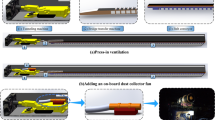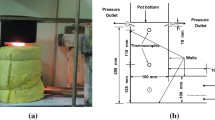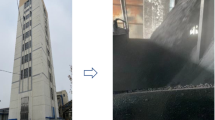Abstract
The air quality significantly affects the state of the environment, human health as well as individual ecosystems, and biomass burning contributes significantly it. The European Union is pushing on regulations of boiler manufacturers in order to reduce the emission concentration. Due to this, manufacturers improve, modify and innovate their products, reduce emissions and also increase the efficiency of the boilers. This research focuses on a particular type of wood-blowing boiler. Many factors directly or indirectly affect the burning quality, which enter the process of incinerating solid dendromass. The distribution of combustion air is one of the factors affecting efficiency and emissions in a small heat sources [1]. The experimental boiler has a supply of primary air to the chamber with wood and the supply of secondary air to the combustion chamber for combustion of the formed wood gas. During the operation of the boiler, uneven wood burning-of and the solid residue were found. Therefore, combustion in such a boiler is less efficient and produces higher emissions. Therefore, it is necessary to analyze the air flow in a particular combustion plant [2]. The actual distribution of combustion air to the dendromass incineration process is impossible to detect by real-time measurement and therefore a suitable alternative of his detection is CFD simulation, which used to optimize the distribution of combustion air in a small heat source [3]. In the first stage, the analyses of the combustion air distribution were performed under various input conditions and consequently the optimization measures of the combustion air distribution were solved. The CFD simulation data will be analyzed using non-invasive visualization measurements using the PIV method in further research.
Access provided by CONRICYT-eBooks. Download conference paper PDF
Similar content being viewed by others
Keywords
1 Introduction
Biomass is increasingly used as a renewable source in industrial and domestic heat production facilities. The European Union is pushing on producers of small heat sources to reduce the formation of emissions and increase the efficiency during biomass combustion. The development is needed in this field in order to achieve the required emission and heat power parameters [4]. There are many aspects, which influence the biomass combustion. One of the most important aspects is the distribution of combustion air in a gasification boiler. The numerical simulation is effective tool to analyze combustion air distribution, since production and experimental measurement are financial and time-consuming [5].
2 Numerical Simulation
Analysis was carried out in the Ansys program on 12 areas in gasification and also combustion space of the heat source with various inlet air settings into a heat source in the range from 10 to 150 m3 h−1.
The analysis of the combustion air distribution in the investigated heat source was realized on a 3D model (see Fig. 1), where the mesh of approximately 7,000,000 elements was generated and then optimized. The object was simulated by the k-ε model, in which standard wall functions and basic lifting effects were set [6].
3 Results
Initial data analyses already show an asymmetrical and unequal distribution of the speed profile. In Fig. 2 is shown the overall course of the airflow distribution in the 3D model and it is easy to identify areas with the higher airflow velocity [7].
Figure 3 shows the cross-sections, which have a vertical direction through the center of the heat source with various inlet airflow settings. When the fan was set on a flow rate of 10 m3 h−1, the combustion air velocity was up to 0.9 m s−1 in the combustion chamber space and in the air distribution section. It can be observed that a larger change of velocity occurred with a flow rate of 40 m3 h−1, where the air velocity in the mentioned areas increased in the range from 2.8 to 4.6 m s−1. The largest change of combustion air velocity was with the volume flow rate of 90 m3 h−1, where the velocity in the air distribution area and the combustion chamber reached a maximum value of 6 m s−1. In the area of redistribution, the air is affected by Coanda effect, is kept on the wall, where the highest velocity is also reached. With an increasing velocity, the airflow is carried from the back part of the boiler to the center in the gasification space, and then is pulled into the nozzle in the front part.
In the following vertical sections, it is possible to see a change during the setting of the fan on a flow rate of 80 m3 h−1 in the area of the air distribution and at the entrance of the secondary air into the space. It is noticeable that the air flows faster along the wall, about 5 m s−1 and rises to a value from 9 to 11 m s−1 in the lower part. In the area of secondary air inlet, there is stream velocity from 4 to 5 m s−1. It can be seen that in the back inlet of the secondary air into the nozzle, the stream is carried at the highest speed (see Fig. 4). In the gasification chamber can observed that air distribution is again directed from the back to the center part and enters into the combustion chamber in the front part, in the case of flow rate 100 m3 h−1. In the combustion chamber, the airflow is uniform with a velocity about 4 m s−1.
In the vertical cuts on the right part of the numerical model is observed larger change in flow velocity with a flow rate of 60 m3 h−1 and again in the air distribution area, where the value is from 4 to 5.5 m s−1. In the area of the combustion chamber is velocity around 1.5 m s−1. The distribution is carried along the wall due to Coanda effect. Other significant changes in velocity is recorded in the fan setting with a flow rate of 100 m3 h−1. In the area of the gasification chamber, the air is distributed from the back part of the boiler forward and it is twisted down into the combustion chamber. There is increased stream velocity to 6 m s−1 in the area of secondary air inlet by increasing the flow rate.
In the horizontal cut of the heat source combustion chamber, a significant change in velocity occurred in the fan setting on a volume flow rate of 90 m3 h−1. The air velocity reached maximum at the center of the chamber and the value was from 2 to 8 m s−1. It is noticeable that the air is equally distributed and flows into the center of the chamber and farther is reflected from the bottom part to the sides.
The change of velocity in the four primary air nozzles, which distribute the air into the gasification chamber, can be seen on the horizontal cut in the lower part of the gasification chamber. A significant change in velocity can be recorded with a flow rate of 90 m3 h−1 in the nozzle of primary air. The value of flow air velocity is in the range from 4 to 5.5 m s−1. It can be seen that the largest amount of air is in the right front nozzle.
In the horizontal cuts (see Fig. 5), which are located in the central part of the gasifying chamber, was observed the air distribution in the center of the gasification chamber and the velocity up to 2.3 m s−1. In the case of flow rate of 130 m3 h−1, it can be seen that the largest air distribution is again in the right front nozzle of primary air and the velocity is about 6 m s−1. In the area of air distribution, there is air flow oriented on the right side. The significant changes in fan velocity setting on a flow rate of 90 m3 h−1 were recorded in vertical cuts that are oriented through the left horseshoe through the primary air inlet. The air distribution is again carried along the wall. The gasification chamber shows that the air flows from the back side of the boiler to the center gradually decreases. In the middle, it deflects back into the back of the chamber. In the area of primary air inlet to the nozzle, there is no significant deviation and flow is uniform there. The air velocity ranges from 1.8 to 4.2 m s−1.
In vertical cuts, which are located over the right horseshoe, was observed the highest change of combustion air flow velocity with a flow rate of 90 m3 h−1 in the air distribution area. The air distribution is again carried along the wall and gradually enters the nozzles. In the gasification chamber, the air is centered on the center and is evenly distributed. Gradually, it decreases lower and slightly deviates on the back side of the boiler. Air velocity in the air distribution area is 6 m s−1. It is possible to see how the velocity decreases during transition to the chamber.
Figure 6 shows a vertical cut, which is directed in the back part of the heat source that passes through the back part of secondary air inlet to the bottom nozzle and also through bottom nozzles, where the primary air flows. The most noticeable change in air velocity is observed in fan setting for flow rate of 90 m3 h−1. The highest velocity is recorded in the bottom nozzle with the velocity of 6 m s−1. In the gasification chamber, there is seen air deviation on the right side. In nozzles of secondary air, the stream is evenly distributed. Bottom air nozzle shows the highest air velocity, but the distribution is slightly deviated on the right side. In the combustion chamber, the air flow is centered on the center and it deviates evenly into the sides in the lower part.
On the vertical cuts (see Fig. 7) in the back part of the heat source done by the central inlet of secondary air to the lower nozzle, during the setting for flow rate on 90 m3 h−1, the highest change of velocity is observed in the lower nozzle area and the combustion chamber. It can be seen that a larger amount of flowing air is located in the right part of the nozzle. In the gasification chamber, the distribution of air is slightly deflected from the center to the right. In the combustion chamber, it is again seen that more air is flowing to the right. The velocity in the nozzle and center of the chamber is 6 m s−1. The vertical sections which are oriented in the back part of the heat source done by the front inlet of the secondary air into the lower nozzle have a similar course like the previous cross sections. Air deflection is realized on the right side. In the combustion chamber, the flow of the stream is more uniform than in the middle or back part of the nozzle inlet. In the case of fan setting for flow rate of 90 m3 h−1, the highest change of velocity is again reached and a value of this is up to 6 m s−1 in the lower nozzle and mid-section of the combustion chamber. In the area of gasification, there is no significant change in velocity, but the deviation of the distribution is again led slightly to the right. In vertical cuts in the front part of the heat source, which are made through the secondary air inlet, during already of a 50 m3 h−1, there is recorded a slight change of velocity in secondary air inlets, where the value is from 2.3 to 3.7 m s−1. The distribution of airflow is relatively uniform. The dramatic change of velocity is occurred again during a volume flow rate of 90 m3 h−1, where the velocity reached a maximum value of 6.0 m s−1. In the gasification chamber, it can be seen that the air is deviated from the center to the right side. In the area of secondary air inlet into the nozzle, there is no large displacement, and the distribution of the combustion air equilibrium is almost optimal [8].
4 Conclusion
Introductory numerical simulations of a 3D combustion air distribution model in an experimental boiler showed lack of combustion air distributions that can cause defects during combustion of dendromass by the gasification. For instance, the incomplete combustion of fuel in the corners of the gasification chamber lead to unequal distribution of the flowing air therein, or in the poor distribution of the secondary and primary air into the gasification nozzle [9]. These imperfections in the combustion air distribution degrade the quality of the combustion of dendromass by the gasification process in the investigated boiler. In the next stage, verification measurements will be realized on the designed and constructed experimental device using the noninvasive visualization method PIV—particle image velocimetry. Based on numerical simulations and verification measurements, optimization of the combustion air distribution will be carried out on the considered small heat source.
References
Holubčík, M., Nosek, R., Jandačka, J., Palacka, M.: Using of local heat sources with warm-water heat exchanger for combustion of wood biomass in low temperature heating systems, Key Eng. Mater. 688, s. 59–64 (2016). ISSN 1013-9826
Nosek, R., Holubčík, M., Jandačka, J., Vician, P.: Formation of emission from combustion of biomass in small heat source. Key Eng. Mater. 688, s. 65–73 (2016). ISSN 1013-9826
Mičieta, J., Vondál, J., Jandačka, J., Lenhard, R.: Optimization principle of operating parameters of heat exchanger by using CFD simulation. In: EPJ Web of Conference, vol. 114, art. no. 02074 (2016)
Vantúch, M., Kaduchová, K., Lenhard, R.: The impact of municipal waste combustion in small heat sources. In: The Application of Experimental and Numerical Methods in Fluid Mechanics and Energy 2016. American Institute of Physics Publishing (2016)
Ďurčanský, P., Lenhard, R., Jandačka, J.: Comparison of mathematical models for heat exchangers of unconventional CHP units. Acta Polytech. J. Adv. Eng. 55(4), s. 223–228 (2015)
Lenhard, R., Mičieta, J., Jandačka, J., Gavlas, S.: Specifics of phytomass combustion in small experimental device, In: EPJ Web of Conference, vol. 92, art. no. 02047 (2015)
Lenhard, R., Kaduchová, K., Jandačka, J.: Numerical simulation of indirectly heated hot water heater. Adv. Mater. Res. 857–877, s. 1693–1697. (2014). ISSN 1022-6680
Galletti, Ch., Parente A., Tognotti, L.: Numerical and experimental investigation of a mild combustion burner [online]. Combust. Flame 151, 649–664 (2007)
Fan, J.R., Liang, X.H., Xu, Q.S., Zhang, X.Y., Cen, K.F.: Numerical simulation of the flow and combustion processes in a three-dimensional, w-shaped boiler furnace [online]. Energy 22(8), 847–857 (1997)
Acknowledgements
This work has been supported by the project VEGA 1/0864/16/7 “Analysis and optimization of the factors entering into the process of burning dendromass in small heat sources”.
Author information
Authors and Affiliations
Corresponding author
Editor information
Editors and Affiliations
Rights and permissions
Copyright information
© 2018 Springer International Publishing AG
About this paper
Cite this paper
Čaja, A., Papučík, Š., Patsch, M., Kantová, N. (2018). The Visualization of Combustion Air Flow that Flows into the Dendromass Combustion Process Using CFD Simulations. In: Mudryk, K., Werle, S. (eds) Renewable Energy Sources: Engineering, Technology, Innovation. Springer Proceedings in Energy. Springer, Cham. https://doi.org/10.1007/978-3-319-72371-6_3
Download citation
DOI: https://doi.org/10.1007/978-3-319-72371-6_3
Published:
Publisher Name: Springer, Cham
Print ISBN: 978-3-319-72370-9
Online ISBN: 978-3-319-72371-6
eBook Packages: EnergyEnergy (R0)











